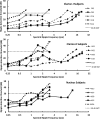Assessing the role of spectral and intensity cues in spectral ripple detection and discrimination in cochlear-implant users
- PMID: 23231122
- PMCID: PMC3529540
- DOI: 10.1121/1.4763999
Assessing the role of spectral and intensity cues in spectral ripple detection and discrimination in cochlear-implant users
Abstract
Measures of spectral ripple resolution have become widely used psychophysical tools for assessing spectral resolution in cochlear-implant (CI) listeners. The objective of this study was to compare spectral ripple discrimination and detection in the same group of CI listeners. Ripple detection thresholds were measured over a range of ripple frequencies and were compared to spectral ripple discrimination thresholds previously obtained from the same CI listeners. The data showed that performance on the two measures was correlated, but that individual subjects' thresholds (at a constant spectral modulation depth) for the two tasks were not equivalent. In addition, spectral ripple detection was often found to be possible at higher rates than expected based on the available spectral cues, making it likely that temporal-envelope cues played a role at higher ripple rates. Finally, spectral ripple detection thresholds were compared to previously obtained speech-perception measures. Results confirmed earlier reports of a robust relationship between detection of widely spaced ripples and measures of speech recognition. In contrast, intensity difference limens for broadband noise did not correlate with spectral ripple detection measures, suggesting a dissociation between the ability to detect small changes in intensity across frequency and across time.
Figures







References
-
- Bacon, S. P., and Brandt, J. F. (1982). “ Auditory processing of vowels by normal-hearing and hearing-impaired listeners,” J. Speech Hear. Res. 25, 339–347. - PubMed
-
- Baer, T., and Moore, B. C. J. (1994). “ Spectral enhancement to compensate for reduced frequency selectivity,” J. Acoust. Soc. Am. 95, 2992.10.1121/1.408905 - DOI
Publication types
MeSH terms
Grants and funding
LinkOut - more resources
Full Text Sources
Medical

